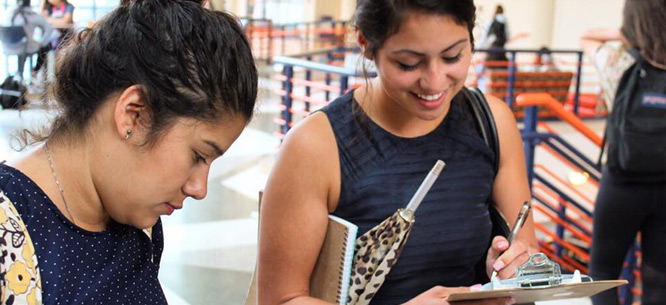Texas Millennials Move the Needle
Texas Millennials Move the Needle
To win in Texas, the Democratic Party will need to build a progressive ecosystem that can engage key constituencies—particularly young voters—throughout the year.

In the United States nearly every major progressive social movement has been fought and won with young people at its forefront—from the civil rights movement to the antiwar and women’s rights movements. Young people have often had the boldest visions for change, employed the most daring tactics, and pushed this country to live up to its promise to guarantee all its citizens the same rights and privileges.
Today, we are seeing a new wave of civic engagement from young people. Millennials are marching for gun control, defending the rights of Dreamers, and mobilizing in the Black Lives Matter movement. The question remains, though, how this generation will consolidate its power, not just in the streets but in the voting booth. Millennials are now the largest, most diverse, and most progressive voting bloc in the country. In my home state of Texas, young people under the age of thirty now make up 43 percent of the population. While 67 percent of Texans over seventy are white, 62 percent of its under-thirty population are people of color. Millennials played pivotal roles in the campaigns of both Barack Obama and Bernie Sanders. Young people showed overwhelming support for both candidates during their Democratic party bids, with Obama taking 60 percent of the youth vote in 2008, and Sanders a whopping 71 percent in 2016. However, despite young people’s numbers and current activism, they are still the least likely to vote of any age group, depressing their ability to move policy on the issues they care about.
While important and inspiring, mass mobilizations like Occupy Wall Street and the immigrant rights marches of 2006 failed to deliver long-term structural change. In fact, since the Occupy Wall Street movement spread to over a hundred cities in the United States, inequality has continued to rise and financial interests have further consolidated their grip on the U.S. economy. Likewise, legislators at the state and federal level didn’t just fail to legalize the status of 11 million undocumented immigrants since 2006 but have used the power of ICE and local law enforcement to target, detain, and deport millions of undocumented immigrants.
Alone, spontaneous moments of disruption do not produce long-term power or change. To make the structural change youth movements seek, they must also consolidate their power electorally.
Unfortunately, the burden to do so is often placed solely on young people. If the Democratic Party, progressive foundations, and established social justice organizations want young people to go to the polls they must realize that they too bear an important share of this burden. In order to help American youth realize their electoral power, progressives need to back them with resources, and by investing in year-round, youth-led organizing and leadership.
The current lack of investment in young people by progressive organizations is both short-sighted and has created a cyclical problem. In Texas, for example, half of all those under the age of nineteen are Latino, and Latinos as a whole make up almost 28 percent of eligible voters in the state. But these two groups—young people and Latinos—have some of the lowest voter turnouts in the country. The Democratic Party has not invested significant resources in getting them to the polls, and as a result, the majority stay home on election day. Instead, Democratic Party strategists have diverted their time and money in pursuit of the elusive Republican swing voter, with minimal results. Since Democrats held statewide office under Governor Ann Richards in the early nineties, the state has experienced significant demographic shifts, making the state’s population both much younger and more diverse. Democratic Party leaders assumed the growing Latino population would automatically create a blue wave in the state. But demographics aren’t destiny—and a failure to invest in these groups has led to Democratic failure in the state.
Today’s new wave of youth activism has caught the attention of many progressives who are drawn not only to their courage, but to their potential electoral power. As progressives attempt to engage and move young people, they should look to Texas. The state offers the ultimate prize—thirty-six congressional seats and thirty-eight electoral votes. Texas also has one of the largest and most diverse youth populations in the country. Additionally, the state came within single digits of turning blue in 2016 and saw nearly 500,000 new voters participate for the first time. This shift has made races once thought unwinnable, competitive.
Today, eyes are on Texas’s Senate race, where Democratic Candidate Beto O’Rourke is looking to unseat Ted Cruz. In the first forty-five days of 2018, O’Rourke, who refused to set up a PAC, raised nearly three times as much as Cruz, with $2.3 million from small donors compared to Cruz’s $803,000. O’Rourke is running a dynamic campaign, holding town halls in nearly every corner of the state and making bold proposals to engage young voters such as legalizing marijuana and defending the rights of immigrants (in Texas 53 percent of young Latinos have at least one immigrant parent). However, he still faces an uphill battle due in large part to the failure of the Democratic Party and progressive donors to invest in young people of color in the state—a demographic that should make up a key part of his base.
Unlike progressives in Texas, the right wing has more than just candidates—it has the support of the pro-life faith community, a robust communications apparatus, organized funding, and a base of conservative leaders who are trusted voices with the ability to influence tens of thousands of voters in the state. The Democratic Party and its candidates must understand that to win in Texas, they need to build a similar ecosystem of progressive institutions that can engage and organize key constituencies—particularly young people—throughout the year.
Today Texas has just a handful of progressive organizations dedicated to engaging young people—even though voters under thirty will make up 33 percent of the electorate by 2022. A recent survey of Texas found that there was less than $4 million invested annually into progressive youth organizing. This, in a state of 28 million people, where people under age thirty total over 12 million residents. Despite the limited investment in progressive youth organizing in the state, organizations like MOVE San Antonio are registering and mobilizing tens of thousands of young voters each year, all on a shoestring budget. MOVE San Antonio runs one of the most cost-effective voter-engagement programs in Texas, yet, in 2017 they operated with a budget of just $115,000, limiting the real impact they could have on the state.
To tap into the full potential of the millennial voting bloc, the Democratic Party, philanthropists, and progressive institutions must confront the ageism and racism that has led to their failure. Some believe that because young people are the most diverse generation in the country, that race has played a role in progressives’ failure to finance youth organizing. Compare the responses to the majority white students of Marjory Stoneman Douglas High School and to the majority brown and Latino youth of the Dreamers and the Black Lives Matter movement. The majority white spokespeople and leaders of the March for Our Lives, which mobilized hundreds of thousands, received significant backing from older donors and established progressive organizations. However, in Texas, when thousands of students walked out of classrooms last year on the Day Without Immigrants, there was no broader effort in the state to develop the leadership, organization, or capacity of these young leaders.
While Texas is now majority minority, fueled in large part by a growing, young, Latino population, demographics alone will not change the electoral outcomes in the state. The national and state Republican Party know this, just as they understand that to hold power in the long term, they must maintain their dominance in key states like Texas. To win, therefore, they must either keep young people disengaged, or harness their power for their own movement. Conservative donors are already trying to attract young voters into conservative organizations like the Koch-backed Generation Opportunity, including by mimicking issues championed by the left such as corporate accountability and student debt (though, of course, inflected by conservative agendas). The right’s long-term strategy, however, is to curb the power of young progressives because they know it spells their own defeat. Will progressives get to them first?
Cristina Tzintzún is the founder and executive director of Jolt, a Latino civic-engagement organization in Texas and author of ¡Presente!: Latin@ Immigrant Voices in the Struggle for Racial Justice (AK Press, 2014).






